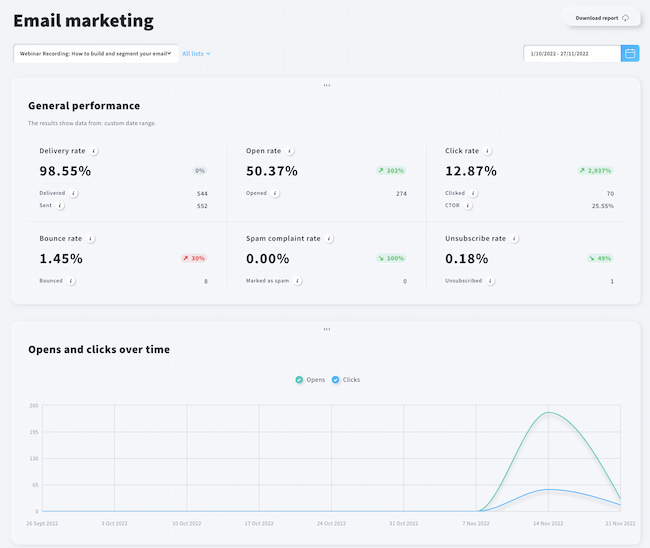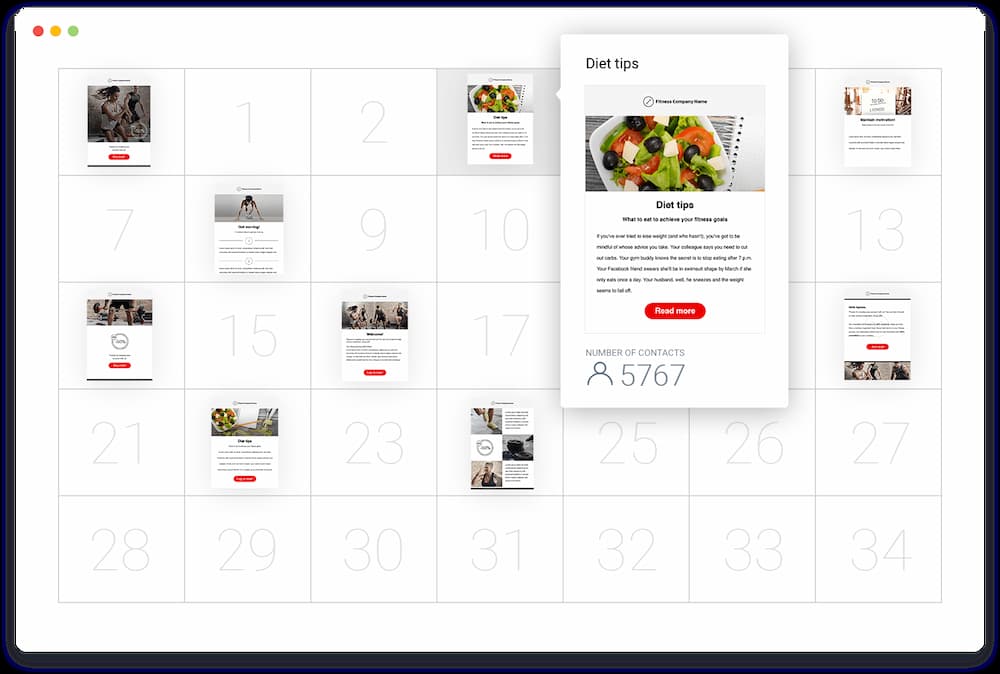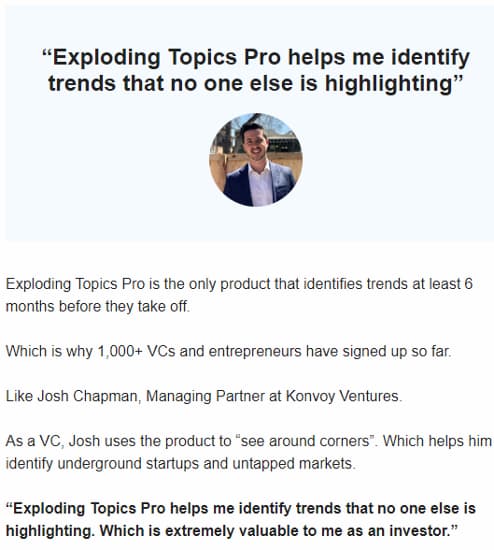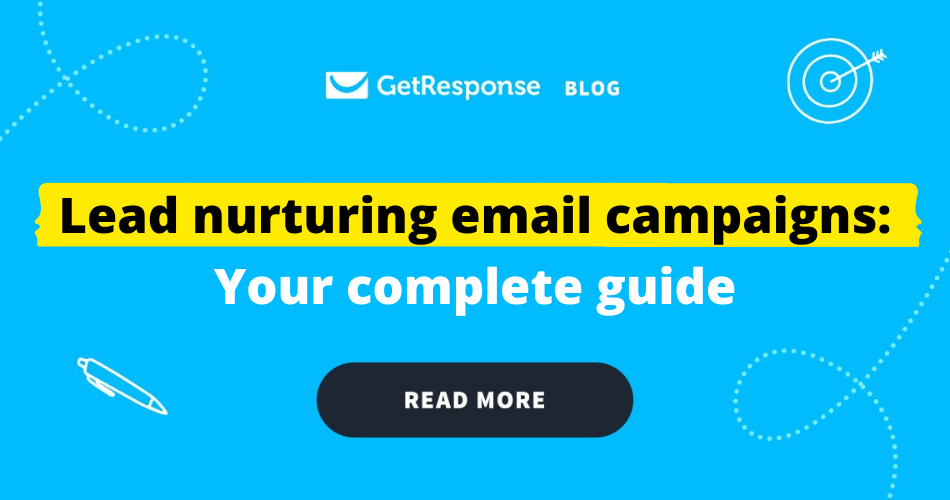Convincing someone to buy from you during that very first contact is a challenge.
This is especially true in the B2B world, where the buying process usually takes longer, is more complex, and involves multiple stakeholders.
That’s why marketers came up with the concept called lead nurturing, where instead of going for the big “yes” right away, you take time to establish a relationship first and only present your offer when the prospect is most likely to convert.
If you’re interested in starting your own lead nurturing campaigns, then you’re in the right place. In this guide, I’ll focus on one specific kind of lead nurturing, one that involves emails.
Keep reading to learn:
What is a lead nurturing email?
A lead nurturing email is a message marketers send to prospects who sign up for their email list. The sequence of those messages constructs lead nurturing email campaigns. And the goal of these campaigns? Establishing a relationship, building trust, and finally enticing potential customers to buy their products or services.
Why are lead nurturing emails crucial for your business?

Recently, I came across an SEO expert who was quoted in an article. His opinion was on point, so I looked up his LinkedIn account (with legions of followers) and his website, where everything was spotless. But was I ready to purchase his (quite expensive) online course or subscribe to his paid newsletter during the first-page visit?
No, I wasn’t. I subscribed to his free newsletter, though. And there I was – a lead that entered the lead nurturing path. Every week since then, I keep receiving emails from him. Some are educational, and some encourage me to purchase that online course (with a limited-time discount, of course).
Despite the emails being super solid and backed with video testimonials and numbers, I still didn’t plug in my credit card. But to be honest, I think I will.
☝️
This is why email lead nurturing is crucial! Your potential customers might feel hooked from the start, but it’s still too premature for them to say, “OK, I will spend my $1K on that service.”
Lead nurturing is about building trust and long-term relationships with future buyers. As long as you stay on their radar and keep engaging them with helpful content, you will increase their chances of clicking the “buy now” button.
Here are other reasons why lead nurturing emails are important for your business:
- They help you stay top of mind – even if your prospect isn’t ready to buy now, it doesn’t mean they won’t convert within the next six months or more. Lead nurturing emails will help you keep your brand at the top of your prospects’ mind, so that they’ll know whom to reach out for more information, when they’re ready to do business.
- They help you run your campaigns more efficiently – by automating parts of your lead nurturing process, you can allocate some of the saved time to better serve prospects who are ready to buy now.
- They can help you shorten the sales cycle – a lead nurturing campaign can help speed up the buying decision among your prospects, since it can deliver relevant information in response to your audiences’ actions.
- They can increase your conversion rates – an email lead nurturing campaign can help you build trust and educate your audience, so that they’ll make better decisions.
Did you know? According to The State of Lead Nurturing for Mid-Size Companies report, 73% of surveyed marketers confirm that they have a lead nurturing program or are working on one. And less than one-third of that group (22% overall) say that their strategy is well-designed and measurable.
Case study:
Landcafe.pl, an online store selling artisanal coffee, converts 54% of their email subscribers into paying customers thanks to an automated email campaign.
The reason why this campaign is so successful is because, as the company’s owner puts it, “Our audience are people who know the difference between the quality of mass-produced and artisanal coffee. Our customers make conscious choices, which gave us the idea for an educational campaign that could make our subscribers more aware and ready to buy.”

Grab this bonus guide
Want to optimize your lead nurturing processes for maximum results? Learn what other mid-sized companies are doing to achieve strong results from the lead nurturing campaigns with this free guie.
Email nurturing – how does it work?
Thanks to your inbound or outbound marketing activities, you’ve successfully generated traffic to your website. By engaging your visitors with compelling content, you’ve convinced them to opt in to your newsletter.
Having a list of people who voluntarily invited your brand to their inboxes is gold already. From that point, you can design a sequence of messages that will provide value and inject upsell and cross-sell offers when it makes sense.
The email nurturing program takes time, but you can keep your finger on the pulse, monitoring the results, adjusting messaging and content, and lead scoring (more on that later).
The finish line of a lead nurturing campaign is converting a lead to a paying customer.
Lead nurturing emails examples
There are many types of messages you can include in your lead nurturing email campaign. We’ve hand-picked a few examples to give you some inspiration.
Welcome email
Subscribing to your newsletter or leaving an email in the process of downloading a piece of gated content should automatically trigger a welcoming message. Here’s how Tango does it:

With minimalistic wording, they nail the pain point of their target audience straight away. After that, they highlight how their product can solve that challenge, using impressive numbers. They also seize the chance to quickly describe how to achieve that, with a CTA leading to a tutorial video.
Pro tip: Check out more inspiring welcome email examples
Educational/thought-leadership
A second commonly used message type falls under an educational/thought-leadership category. Building trust is a long-run program, and crafting messages like this one from the Founder of CXL gradually builds the power of your personal brand.

While you might say it’s a bit text-heavy, this category of lead nurturing emails gets away with it.
New features
Whether you introduce something new to your offering – your product’s freshly released feature, a new type of consultancy, or a service – it makes absolute sense to inform your subscribers about it.
Here’s an example from Loom:

Pay attention to the call-to-action button – while “Learn more” is one of the most generic CTAs out there, it clearly shows the purpose of this email. It says, “No, no, we don’t want to sell to you right now. Just look at what we have.”
Webinar invitation
Another popular nurturing email type is about inviting subscribers to a webinar or an online conference. It also comes down to practical knowledge sharing and helping people achieve their business goals.
Here’s our own (shameless plug) example of a webinar invitation, particularly targeted at ecommerce players:

Pro tip: Want to improve your webinar signups? Check out these webinar invitation emails and what makes them so effective.
Special offer
Finally, you want to convert your subscribers to customers at some point or upsell and cross-sell existing customers. Take a look at the two examples of sales promo emails from Qode Interactive and Grammarly:


Lead nurturing email best practices
OK, since we took a peek at how others do it, it’s time to build your own email lead nurturing action plan. It’s also crucial to adopt a mindset of being consistent and dedicated. An efficient lead nurturing program is an ongoing and long-term process.
Know your audience
This principle should be tattooed in the mind of every entrepreneur, marketer, and salesperson. Without knowing the profile of your target customer, you won’t be able to create email content that hits the nail on the head.
There are a few ways to get to know your audiences’ pains, gains, and preferences:
- Running online surveys or interviews upfront
- Using a platform such as SparkToro or Audiense
- Creating simple forms that your subscriber can fill in when they opt-in. If you have a few segments in your mind, ask them who they are and then customize the upcoming sequence of emails. Feel free to be explicit: “Hi, I’m pumped to see you here! Please select one of the following choices that describe you most accurately, so you will receive tailored tips and insights: 1) I’m a small-business owner, 2) I run an online store, 3) I’m a marketer in a bigger company.”
Personalize your emails
The first thing that can come to mind is using your recipients’ first names at the beginning of each email. Yes, injecting that personal touch can positively impact your relationship with potential customers, but there’s more to it.
Most importantly, having the data about your subscribers’ profiles will define what email sequence you will be sending them. For instance, for ecommerce professionals, you’ll focus on content regarding online shopping marketplaces and strategies for pricing and listing their products.
But that’s not all. Email personalization can result from specific user behavior – how have they interacted with your website and emails so far?
Create a welcome series
Once you know the above, you can design a specific welcome series adjusted to potential customers’ segments. The email series structure can look like this:
- Welcome
- Excited to have you here
- How to start X
- X proven ways to achieve…
- The anatomy of a successful…
- [Brand name] achieved [success metric] with [your service]
- Webinar invitation
- Don’t make my rookie mistake
You can learn how to create a welcome email series from our webinar, where we’ve not only gone through the process step by step, but also provided valuable tips on improving your email communication.
Provide valuable insights
One of the welcoming emails that got etched in my memory: “Hot damn, I’m flattered that you invited me into your inbox.” It resonates so much because an inbox is something private that people think twice before sharing.
So, if they invite you to their inboxes, ensure the content you share is worth their attention. No fluff, nothing too salesy, no generic tips. Make sure your email content is unique, powered by expertise, and real-life examples and achievements.
Test different types of emails
The way you design the architecture of your lead nurturing campaigns is up to you. Having a welcome email on your list is obvious, but we suggest you experiment with different types of messages for the rest.
The best tip is not to get attached to specific types, and replace them with something new when they underperform. Email content can also result in different engagements in each segment of your audience (if you have more than one) – a webinar invitation could be a winner for one cohort while missing the target for the second group of subscribers.
Track engagement
Speaking of performance, there are a few fundamental metrics you should monitor as your emails go out:
- Open rate – to give you a benchmark, an average open rate (OR) in the US is 23.53%, and for Europe it’s 25.18%
- Click-through rate – according to the same Email Marketing Benchmarks report, the average click-through rate (CTR) in the US is 3.86%, while in Europe it’s 2.56%
- Click to open rate – the average in the US is 16,4%, and in Europe, it is 10.16%
- Unsubscribe rate – the US average is 0.1%, whereas the European average is on the 0.15% level
- Spam rate – the same average for the US and Europe – 0.01%
- Bounce rate – US email recipients tend to bounce more frequently (3.42%) than Europeans (2.46%)
And here’s how you can start your adventure with email analytics in GetResponse, where you can also analyze the click maps to know which links triggered the highest number of clicks:

Use tagging and lead scoring
OK, so you know your emails’ open rates, CTRs, and unsubscribe rates, and it gives you an overview of how effective your messages are. But that’s the first instance of your analysis and data-driven decision process.
The bottom line of those campaigns is about leads and how likely they are to move down the funnel.
This is where tagging and scoring come into play. Implementing those two activities will help you identify which leads are more active and more prone to become customers:
- Scoring is about adding or subtracting points according to specific actions on the subscribers’ side. Did they open your message? Did they click a particular link? Did they go to your landing page? Did they abandon the shopping cart? For every “yes” or “no” answer, you can score them with points.
- Tagging helps you organize your contact database by labeling your leads according to their behavior. Once you know who is active, engaged, or dormant, you can decide what type of content to send in each case.
Reactivate sleepyheads
Many of us are guilty of submitting our emails here and there and then ignoring all the incoming messages from those websites. And worst of all – NOT unsubscribing.
Dormant subscribers can be your headache because the fact that they don’t open your emails will hurt your deliverability. And as a result, your ICP can automatically flag your content as irrelevant, and your upcoming messages will end up in a spam folder.
There are three things you can do to solve it:
- Ask them to unsubscribe. Yes, that might sound counterintuitive. But imagine that sending a “should you stay or should you go” email can help weed out contacts that will never convert and sort out the deliverability issues.
- Double down on sending them more engaging content. Try playing with enticing subject lines, promo codes, or case studies.
- If your efforts bring no results, manually remove them from your list.
Reward the most engaged subscribers
Oh, the most active contacts will always increase your levels of serotonin. They open most of your emails, read them, and in most cases, visit your landing pages.
Yet, they still hesitate before the touchdown. You can score and tag them as your top priority leads and keep sending them what already has been encouraging them to click. Or you can reward them for being so active by:
- Offering them a free consultation
- Sending them your paid newsletter for free
- Giving them access to a beta version of your product
Make them feel special, simple as that.

Ecommerce Marketing Automation
Learn how to create automated scenarios for ecommerce! Download premade templates and get your business growing today!
Optimize the process with the right tools and automation
As an entrepreneur, you already have tons of tasks and projects on your plate. And running consistent lead nurturing email campaigns can look complex, challenging, and time-consuming.
The good news is that with an email marketing toolkit and automation, you can save a lot of time and refocus on strategic aspects of your business. And no – setting up automation is not rocket science!
Get started with automated email sequences
Sending a welcome message or another lesson from your email course can be manual. Or it can go on autopilot with GetResponse’s Autoresponders, where you can:
- Create and customize the content of your emails
- Choose the time for your email to be sent out

It’s a great option to automate that first message your contacts will receive after hitting the “subscribe” button on your website (or elsewhere). You can decide how soon they’ll receive your welcoming email after joining your email list.
After setting it up, you can add more autoresponders to your calendar if you, for instance, want to send consecutive lessons from your online course automatically.
To learn how to set up autoresponders inside GetResponse, check out this video:
Related: Guide to email drip campaigns
Amplify your conversions with marketing automation
However, if you want to become advanced in email lead nurturing, your ideal option would be GetResponse’s Marketing Automation.
With this set of tools, you will be able to:
- Run email campaigns based on your contacts’ behavior
- Better understand your future customers by assigning them tags and scoring
- Send relevant messages tailored for specific segments of users
But the most exciting part is about building workflows! You can either build one from scratch, or use a prebuilt template for any of the below categories:
- Welcome
- Lead qualifying
- Engagement and retention
- Post-purchase
- Abandoned cart
- Online courses
- Webinars and events
- Sales promotions
- Affiliate marketing
To learn more about building marketing automation workflows, watch the following video tutorial or read our getting started with marketing automation guide.
Here are some examples of prebuilt workflows you’ll find in the platform:
1. Basic scoring plan

2. Win back workflow

3. Abandoned cart

How to write a lead nurturing email
As you noticed, one crucial element appears in every marketing automation workflow – “select a message to send.”
So, how do you create a message that will deliver results?
Here’s our 9-step process you can use right away:
1. Choose your segment
The content, the angle, and the messaging would be different for CTOs, financial directors, HR managers, heads of marketing, etc. Select your segment and go through this audience’s goals and pain points. Only have one segment? Still, bear in mind who you’re talking to.
2. Select your message type
For every type of lead nurturing email, there will be a different construction of the message. A welcome email wouldn’t be like a webinar invitation or a post-download follow-up. Selecting a particular type will affect how you build your message.
3. Write a subject line and preheader
Those two elements will play a decisive role in your open rates. Some marketers claim that a subject line doesn’t have to be sophisticated. On the contrary, they praise “boring” subject lines as the most effective ones – such as “Affiliate Marketing” vs. “11 Proven Strategies for Affiliate Marketing”.
Choose the approach you want to take, or better yet, find the best approach by running an A/B test.
4. Focus on the pain point
Managed to get your contacts to open your message? Great! Now you have seconds to glue them to their screens. Don’t start with anything general. Try the Problem-Agitate-Solve (PAS) formula. Nail it by calling out the challenge. Then, magnify its consequences. And last – introduce the solution.

5. Tell a story
It can apply to every email type. Adding a real-life example, story, or anecdote will magnify your message. Reading theories is boring. Diving into juicy stories – this is what humans fall into.

6. Write like you talk
Well, almost – you can skip the “uuhhmm” ?. But make it conversational, with a natural flow. A lead nurturing email is not a university lecture, nor a technical instruction packed with passive voice and jargon.

7. Inject case studies and testimonials
Whenever you have a chance (and some solid quotes up your sleeve), drop a testimonial that will help you to sell or upsell your contacts. Here’s an example from the Exploding Topics newsletter, where below the info about rapidly trending topics, there is a powerful social proof section:

8. End with a CTA
A clear call-to-action should be the bottom line of every lead nurturing email. Depending on the message type, a CTA button could send your contacts to your blog article, a landing page with a special offer, or a webinar registration page. Avoid generic CTAs, such as “Learn more,” and experiment with wording.

9. Give them a chance to unsubscribe
Including an unsubscribe button is not optional. Seeing people opting out of your email list is not the most exciting part of email marketing, but it has a bright side too. Think of it this way – if they decide to abandon you, they are highly unlikely to become your customers.
And if you don’t want them to go away just yet, consider offering them an opt-down option or freezing their subscription for some time.
Start your email lead nurturing campaign
Alright! You’re all set to start or reshape your email lead nurturing campaign! Remember that it’s a process where there’s always room for testing and implementing changes to drive more substantial results. And if you want to try building your first marketing automation workflow, you can do it with GetResponse in no time.
Source link



